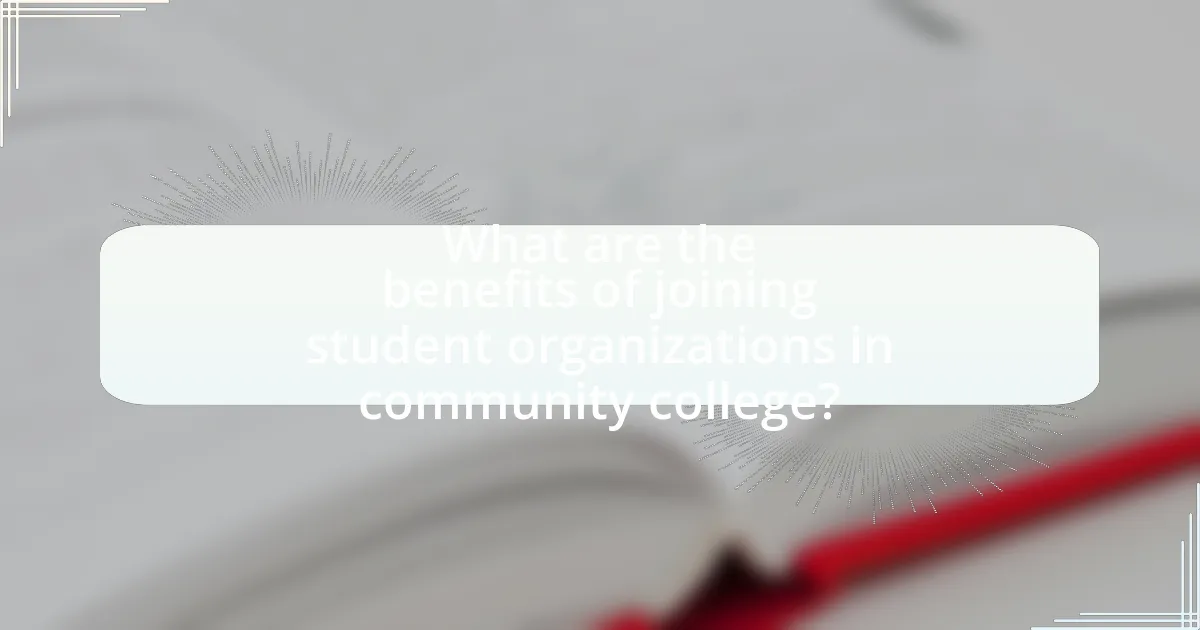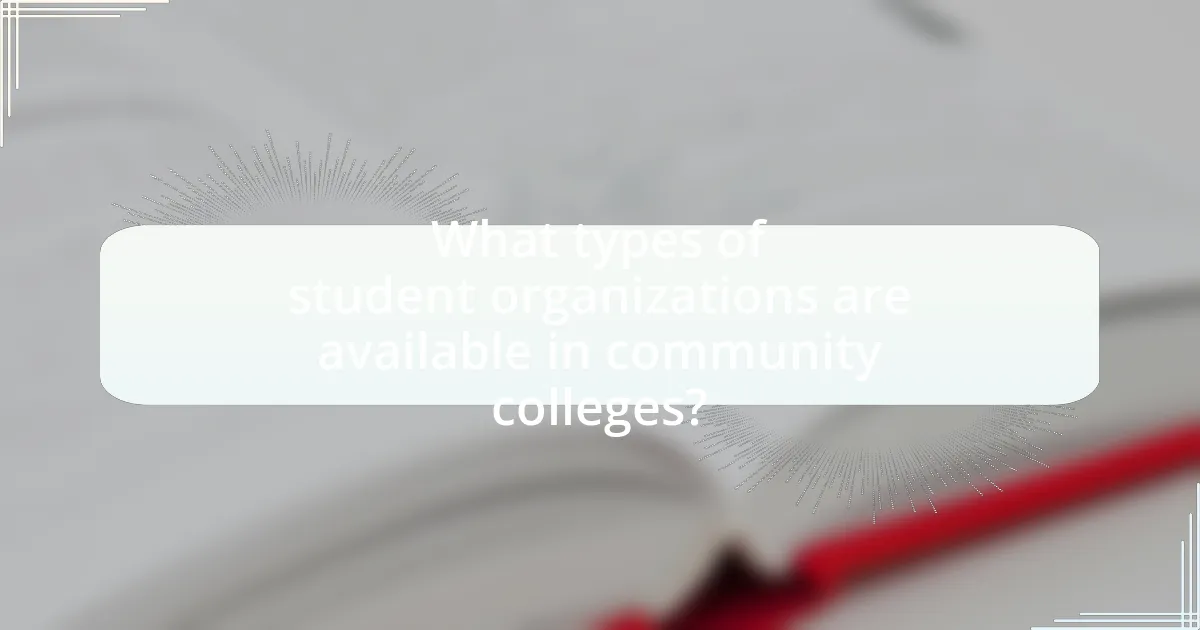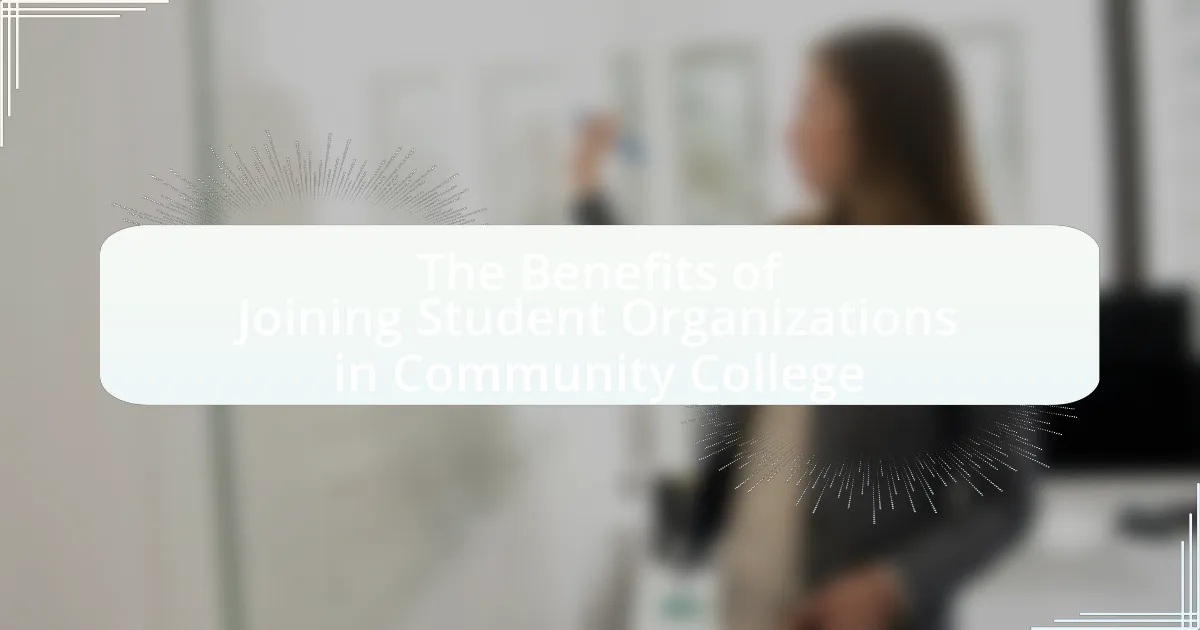Joining student organizations in community college provides significant benefits, including enhanced social connections, skill development, and improved academic success. These organizations foster a sense of belonging, which is crucial for student retention, and contribute to higher GPAs and graduation rates. Participation in these groups allows students to develop essential skills such as leadership, teamwork, and communication, while also offering networking opportunities that can lead to internships and job placements. The article explores various types of student organizations, their impact on academic performance, personal development, and community engagement, as well as strategies for maximizing involvement and leveraging experiences for future opportunities.

What are the benefits of joining student organizations in community college?
Joining student organizations in community college offers numerous benefits, including enhanced social connections, skill development, and increased academic success. These organizations provide opportunities for students to meet peers, fostering a sense of belonging and community, which is crucial for retention rates; studies show that students involved in campus activities are more likely to persist in their studies. Additionally, participation in these groups helps students develop leadership, teamwork, and communication skills, which are highly valued by employers. Research indicates that students engaged in extracurricular activities often achieve higher GPAs and are more likely to graduate on time, demonstrating a clear link between involvement in student organizations and academic performance.
How do student organizations enhance academic success?
Student organizations enhance academic success by providing networking opportunities, fostering collaboration, and offering resources that support learning. These organizations create environments where students can share knowledge, participate in study groups, and engage in academic discussions, which can lead to improved understanding of course material. Research indicates that students involved in organizations often achieve higher GPAs and have better retention rates compared to their peers who are not involved. For instance, a study published in the Journal of College Student Development found that participation in student organizations positively correlates with academic performance, as students develop skills such as time management and teamwork that are essential for academic success.
What skills can students develop through participation in these organizations?
Students can develop leadership, teamwork, communication, and problem-solving skills through participation in student organizations. Engaging in these organizations often requires students to take on leadership roles, collaborate with peers, and effectively communicate ideas, which enhances their ability to work in diverse teams. For instance, a study by the National Association of Student Personnel Administrators found that students involved in organizations reported improved interpersonal skills and increased confidence in their ability to lead and collaborate. This evidence supports the assertion that active participation in student organizations fosters essential skills that are valuable in both academic and professional settings.
How do student organizations contribute to improved grades and retention rates?
Student organizations contribute to improved grades and retention rates by fostering a sense of community and providing academic support. Research indicates that students involved in organizations often experience enhanced engagement, which correlates with higher academic performance. For instance, a study published in the Journal of College Student Development found that students participating in extracurricular activities had a 20% higher retention rate compared to non-participants. Additionally, these organizations often offer tutoring, mentorship, and networking opportunities, which further support academic success and encourage students to remain enrolled.
What social benefits do student organizations provide?
Student organizations provide significant social benefits, including enhanced networking opportunities, improved social skills, and a sense of belonging. These organizations facilitate connections among students, allowing them to build relationships that can lead to lifelong friendships and professional networks. Research indicates that students involved in organizations report higher levels of social engagement and satisfaction, which contributes to their overall well-being. For instance, a study published in the Journal of College Student Development found that participation in student organizations positively correlates with increased social integration and support, highlighting the importance of these groups in fostering community and collaboration among peers.
How do these organizations foster a sense of belonging among students?
Student organizations foster a sense of belonging among students by creating inclusive environments that encourage participation and connection. These organizations often host events, workshops, and social gatherings that allow students to interact, share experiences, and build relationships. For instance, research from the American College Health Association indicates that students involved in campus organizations report higher levels of social integration and satisfaction, which directly correlates with a sense of belonging. Additionally, these organizations provide mentorship opportunities and peer support, further enhancing students’ feelings of community and acceptance within the college environment.
What networking opportunities arise from joining student organizations?
Joining student organizations provides significant networking opportunities, including connections with peers, faculty, and industry professionals. These organizations often host events, workshops, and guest speaker sessions that facilitate direct interaction with individuals who share similar interests and career goals. For instance, a study by the National Association of Colleges and Employers found that 70% of jobs are obtained through networking, highlighting the importance of building relationships within these groups. Additionally, student organizations frequently collaborate with local businesses and alumni, creating pathways for internships and job placements, further enhancing professional networks.
How do student organizations promote personal development?
Student organizations promote personal development by providing opportunities for leadership, teamwork, and skill-building. Through active participation, students enhance their communication, problem-solving, and organizational skills, which are essential for personal growth. Research indicates that involvement in student organizations correlates with increased self-esteem and a greater sense of belonging, as highlighted in a study published in the Journal of College Student Development, which found that 70% of participants reported improved interpersonal skills and confidence after joining such groups.
What leadership skills can students gain through active involvement?
Students can gain essential leadership skills such as communication, teamwork, problem-solving, and decision-making through active involvement in student organizations. Engaging in these organizations allows students to practice articulating their ideas clearly, collaborating with diverse groups, and navigating challenges collectively. Research indicates that participation in extracurricular activities enhances leadership capabilities; for instance, a study by the American College Health Association found that students involved in organizations reported higher levels of leadership skills and self-efficacy. This active engagement fosters an environment where students can develop and refine their leadership abilities in real-world contexts.
How do student organizations encourage community engagement and service?
Student organizations encourage community engagement and service by organizing volunteer opportunities and community service projects that directly involve students. These organizations often collaborate with local nonprofits and community groups to identify needs and mobilize students to address them, fostering a sense of responsibility and connection to the community. For instance, a study by the National Association of Student Personnel Administrators found that students involved in organizations that focus on service are 30% more likely to participate in community service activities compared to their peers not involved in such organizations. This active participation not only enhances students’ social skills and leadership abilities but also strengthens community ties, demonstrating the impactful role of student organizations in promoting civic engagement.

What types of student organizations are available in community colleges?
Community colleges offer a variety of student organizations, including academic clubs, cultural organizations, service groups, and recreational clubs. Academic clubs focus on specific fields of study, such as business or science, providing networking and professional development opportunities. Cultural organizations celebrate diversity and promote awareness of different cultures through events and activities. Service groups engage in community service projects, fostering civic responsibility among students. Recreational clubs provide opportunities for social interaction and physical activity, enhancing student life on campus. These organizations contribute to personal growth, skill development, and a sense of belonging within the college community.
How do academic clubs differ from social clubs?
Academic clubs focus on enhancing knowledge and skills related to specific subjects or fields, while social clubs prioritize social interaction and community building. Academic clubs often involve activities such as study sessions, guest lectures, and workshops aimed at academic improvement, whereas social clubs typically organize events like parties, outings, and recreational activities to foster friendships and social networks. The distinction is evident in their objectives; academic clubs aim to support educational goals, while social clubs emphasize personal connections and leisure.
What are some examples of academic clubs in community colleges?
Examples of academic clubs in community colleges include the Math Club, Science Club, and Debate Club. These clubs provide students with opportunities to engage in academic discussions, collaborate on projects, and enhance their understanding of specific subjects. For instance, the Math Club often organizes tutoring sessions and math competitions, while the Science Club may host guest speakers and field trips related to various scientific disciplines. The Debate Club helps students develop critical thinking and public speaking skills through structured debates and competitions.
What roles do social clubs play in student life?
Social clubs play a crucial role in student life by fostering community, enhancing social skills, and providing networking opportunities. These organizations create a sense of belonging among students, which is essential for emotional well-being and academic success. Research indicates that students involved in social clubs report higher levels of satisfaction with their college experience, as they engage in collaborative activities that promote teamwork and leadership skills. Additionally, participation in social clubs can lead to valuable connections that benefit students in their future careers, as networking is a key component of professional development.
What are the benefits of joining cultural and diversity organizations?
Joining cultural and diversity organizations provides individuals with enhanced social connections, increased cultural awareness, and opportunities for personal growth. These organizations foster a sense of belonging and community, allowing members to engage with diverse perspectives and experiences. Research indicates that participation in such organizations can improve interpersonal skills and promote inclusivity, which is essential in today’s multicultural society. Additionally, involvement in these groups often leads to networking opportunities that can benefit academic and career advancement, as members build relationships with peers and professionals from various backgrounds.
How do these organizations promote inclusivity on campus?
Organizations promote inclusivity on campus by creating diverse environments that welcome students from various backgrounds. They achieve this through initiatives such as hosting multicultural events, providing resources for underrepresented groups, and fostering open dialogue about inclusivity. For example, student organizations often collaborate with cultural clubs to celebrate different heritages, which enhances awareness and understanding among the student body. Additionally, these organizations may implement mentorship programs that connect students with peers and faculty who share similar experiences, thereby reinforcing a sense of belonging. Research indicates that inclusive campus environments lead to higher student engagement and retention rates, demonstrating the effectiveness of these organizations in promoting inclusivity.
What unique experiences do cultural organizations offer to students?
Cultural organizations offer students unique experiences such as exposure to diverse cultural practices, opportunities for artistic expression, and engagement in community service projects. These organizations facilitate cultural exchange through events like festivals, workshops, and performances, allowing students to learn about different traditions and perspectives. For instance, participation in a cultural festival can enhance students’ understanding of global cultures, fostering inclusivity and empathy. Additionally, involvement in these organizations often leads to skill development in areas such as leadership, teamwork, and communication, which are essential for personal and professional growth.
How can students find the right organization for their interests?
Students can find the right organization for their interests by researching available student organizations at their community college and aligning them with their personal passions and career goals. This process involves reviewing the college’s website, attending club fairs, and speaking with current members to gain insights into the organization’s activities and culture. According to a study by the American Association of Community Colleges, involvement in student organizations enhances student engagement and satisfaction, indicating that finding a suitable organization can significantly impact a student’s college experience.
What resources are available for exploring student organizations?
Resources available for exploring student organizations include college websites, student handbooks, and campus events. College websites typically feature directories of student organizations, detailing their missions, activities, and contact information. Student handbooks often provide guidelines on how to join or start organizations, along with a list of active groups. Additionally, campus events such as club fairs and orientation sessions allow students to meet representatives from various organizations, facilitating direct engagement and exploration. These resources collectively support students in finding organizations that align with their interests and goals.
How can students assess which organization aligns with their goals?
Students can assess which organization aligns with their goals by evaluating their personal interests, career aspirations, and the mission of the organization. This involves researching the organization’s activities, values, and past projects to determine if they resonate with the student’s objectives. For instance, a student interested in environmental science should look for organizations focused on sustainability initiatives or conservation efforts. Additionally, students can seek feedback from current members about their experiences and the organization’s impact on their professional development. This method is supported by studies indicating that involvement in relevant organizations enhances skill development and networking opportunities, which are crucial for career advancement.

How can students maximize their experience in student organizations?
Students can maximize their experience in student organizations by actively participating in events, taking on leadership roles, and networking with peers and faculty. Engaging in events allows students to develop skills and build relationships, while leadership roles enhance their organizational and communication abilities. Networking within these organizations can lead to valuable connections that may benefit their academic and professional careers. Research indicates that students involved in extracurricular activities, such as student organizations, report higher levels of satisfaction and academic success, demonstrating the positive impact of active participation.
What strategies can enhance participation in student organizations?
To enhance participation in student organizations, implementing targeted outreach and engagement strategies is essential. These strategies include hosting informational sessions that clearly outline the benefits and opportunities within the organizations, which can increase awareness and interest among students. Research indicates that active recruitment efforts, such as personalized invitations and social media campaigns, can significantly boost participation rates. For instance, a study by the National Survey of Student Engagement found that institutions that actively promote student organizations see a 25% increase in student involvement. Additionally, creating a welcoming environment through inclusive events and peer mentorship programs fosters a sense of belonging, encouraging more students to join and participate actively.
How can students balance academics and organization commitments?
Students can balance academics and organization commitments by prioritizing time management and setting clear goals. Effective time management involves creating a structured schedule that allocates specific time blocks for studying, attending classes, and participating in organization activities. Research indicates that students who utilize planners or digital calendars report higher academic performance and lower stress levels, as they can visualize their commitments and deadlines. Additionally, setting clear, achievable goals for both academic and organizational involvement helps students maintain focus and motivation, ensuring that neither area is neglected.
What role does effective communication play in organization success?
Effective communication is crucial for organizational success as it fosters collaboration, enhances problem-solving, and drives engagement among members. When communication is clear and open, it allows for the efficient exchange of ideas, which can lead to innovative solutions and improved decision-making. Research indicates that organizations with strong communication practices experience 47% higher employee engagement, which directly correlates with increased productivity and retention rates. Furthermore, effective communication helps to align goals and expectations, reducing misunderstandings and conflicts, ultimately contributing to a more cohesive and successful organization.
What are the best practices for leadership within student organizations?
Effective leadership within student organizations involves clear communication, delegation of responsibilities, and fostering an inclusive environment. Clear communication ensures that all members understand goals and expectations, which enhances collaboration and reduces misunderstandings. Delegation of responsibilities empowers members, allowing them to take ownership of tasks and develop their skills, which is crucial for personal growth and organizational success. Fostering an inclusive environment encourages diverse perspectives, leading to more innovative solutions and a stronger sense of community. Research indicates that organizations with inclusive practices experience higher member satisfaction and retention rates, reinforcing the importance of these leadership practices in student organizations.
How can students develop their leadership style through these organizations?
Students can develop their leadership style through student organizations by actively participating in leadership roles and engaging in collaborative projects. These organizations provide opportunities for students to practice decision-making, conflict resolution, and team management, which are essential components of effective leadership. Research indicates that involvement in such organizations enhances leadership skills; for instance, a study published in the Journal of College Student Development found that students who held leadership positions reported higher levels of self-efficacy and leadership competence. By taking on responsibilities within these groups, students can refine their personal leadership style and gain valuable feedback from peers and mentors.
What are common challenges leaders face in student organizations?
Leaders in student organizations commonly face challenges such as managing diverse group dynamics, securing funding, and maintaining member engagement. Diverse group dynamics can lead to conflicts and differing priorities, making it difficult for leaders to unify the team towards common goals. Securing funding is often a significant hurdle, as many student organizations rely on limited budgets and must navigate complex funding processes. Additionally, maintaining member engagement is crucial; leaders must find ways to motivate members and ensure active participation, which can be challenging in a college environment where students have competing academic and personal commitments. These challenges are well-documented in studies on student leadership, highlighting the complexities of leading diverse groups in educational settings.
What tips can help students make the most of their involvement?
To make the most of their involvement in student organizations, students should actively participate in meetings and events, as engagement leads to deeper connections and learning opportunities. Research indicates that students who are involved in campus activities report higher satisfaction and academic success, with a study by Astin (1999) showing that involvement positively correlates with student retention and achievement. Additionally, students should seek leadership roles within organizations, as these positions enhance skills such as teamwork, communication, and problem-solving, which are essential for future career success. Networking with peers and faculty through these organizations can also provide valuable resources and mentorship, further enriching the college experience.
How can students leverage their organization experience for future opportunities?
Students can leverage their organization experience for future opportunities by highlighting the skills and competencies gained through active participation. Engaging in student organizations fosters leadership, teamwork, and communication skills, which are highly valued by employers. For instance, a survey by the National Association of Colleges and Employers (NACE) indicates that 80% of employers seek candidates with strong interpersonal skills, often developed through collaborative projects in organizations. Additionally, networking opportunities within these groups can lead to internships and job placements, as 70% of jobs are found through networking, according to a study by the Bureau of Labor Statistics. Thus, students can effectively translate their organizational involvement into tangible career advantages.
What are the key takeaways from participating in student organizations?
Participating in student organizations provides essential skills such as leadership, teamwork, and networking opportunities. These organizations foster personal growth by allowing students to engage in collaborative projects, enhancing their ability to work effectively with diverse groups. Research indicates that students involved in such organizations often report higher levels of satisfaction and academic success, as they develop a sense of belonging and community. For instance, a study by the National Survey of Student Engagement found that students who participate in extracurricular activities are more likely to persist in their studies and achieve higher GPAs compared to those who do not engage in such activities.

Leave a Reply